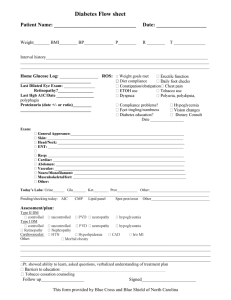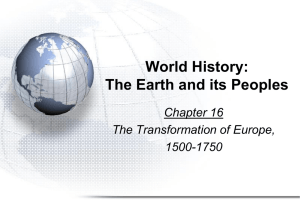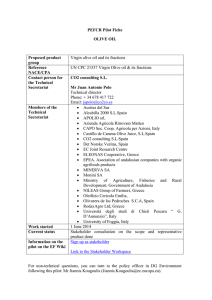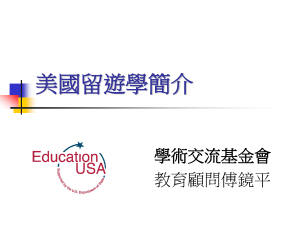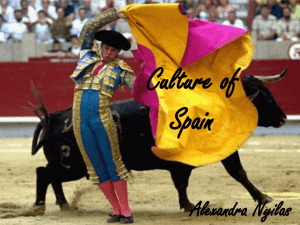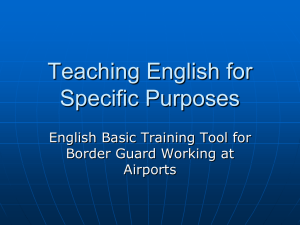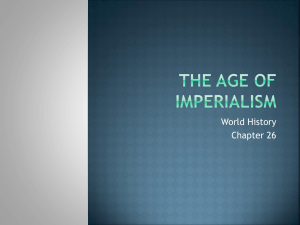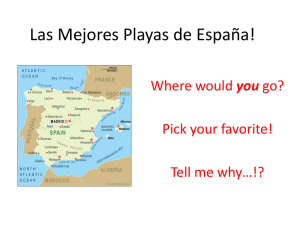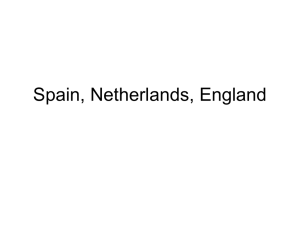File - Ms. Myer`s AP World History
advertisement
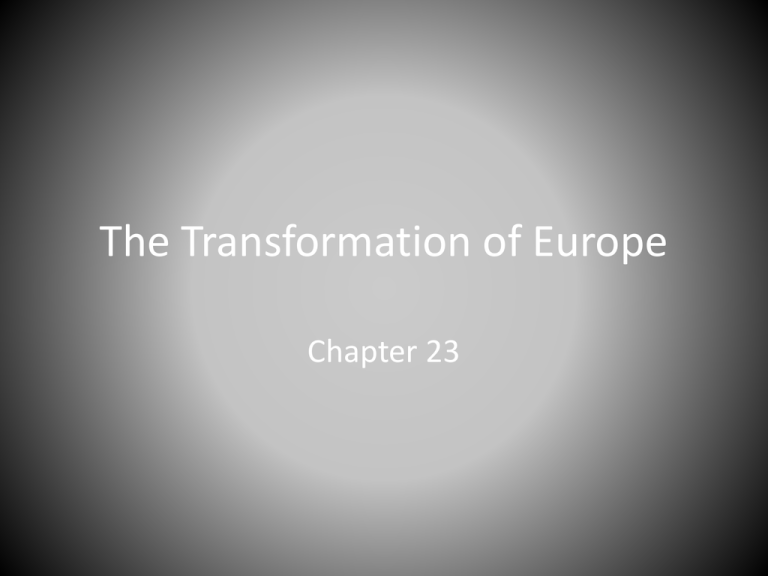
The Transformation of Europe Chapter 23 The Fragmentation of Western Christendom • Christianity had united a culturally diverse Europe • 16th-17th centuries: revolts against the Catholic Church ended that unity – Protestants est’d independent churches – Roman Catholic Church responded The Protestant Reformation • Problem: connection between church officials and politics greed and corruption = hypocrisy criticism and demand for personal involvement with the divine • Martin Luther: Ninety-Five Theses (1517) – Main issues: indulgences, monasteries, Latin bible, priestly authority (esp. pope), focus on actions – Success: printing press, followers, Lutheran church, German princes, spread all over Europe Protestant Reformation (cont.) • Outside Germany: Switzerland, Low Countries, Italy, Spain, England (Henry VIII -> Anglican Church) • John Calvin: French, organized Protestants in Switzerland, codified Protestant teachings, inspired missionaries (esp. in Netherlands and Scotland) The Catholic Reformation • Goals: response to Prot. Ref., clarify differences, persuade converts to return, deepen rel. commitment of Catholics) • Council of Trent: assembly of church leaders, met 1545-1563 – Acknowledged abuses, defined theological elements, set standards of morality for officials, set up schools/seminaries to prepare priests The Catholic Reformation (cont.) • St. Ignatius Loyola: founded Society of Jesus (Jesuits) to extend reforms – Education in theology, phil., classical languages, lit., history, science – Produced excellent missionaries: became counselors to kings and rulers and brought Christianity to India, China, Japan, Philippines, and the Americas Religious Tension: Witch-Hunts • Religious divisions social and political conflict, including witch-hunts in areas with lots of tension between Prot and Cath • European belief that some had special powers (=witches) • Late 15th century: theologians decided it came from the devil in exchange for worship – Witches became scapegoat for crop failures, fires, deaths, inability to conceive; spread to America – Suspects were tried, and many executed by hanging or burning at the stake (most were poor, old, single/widowed women = marginalized) Religious Tension: Wars • Within countries (France: 1562-98 between Cath and Prot) • Between countries (Spain (Cath) and England (Prot) -> demise of Spanish Armada) and (Spain (Cath) and Netherlands (Prot) -> rebellion and independence of United Provinces) Religious Tension: Wars (cont.) • The Thirty Years’ War (1618-1648): – Holy Roman Empire tried to force Bohemians back to Cath. – Other countries got involved – Motives for involvement varied: political, economic, and complicated by religion – Results: violent, brutal, destructive to economies and society (1/3 of German pop. died) Consolidation of Sovereign States • Monarchs used religious issues to strengthen states and enhance their own authority • H.R.E. attempted empire-building • Monarchs raised funds to ensure their positions • Constitutional state & absolute monarchy emerge • Balance of power must be maintained among states Attempted Revival of Empire • H.R.E.: included Germany and N. Italy, but opposition from local princes • Charles V (Hapsburg Dynasty) tried to build empire through marriage alliances (land and titles) -> Austria, Low Countries, Spain – But, could not maintain authority (religious issues, princes, no single admin. structure) – Army put down rebellions, did not expand H.R.E.: Foreign Challenges • France and Ottomans feared empire – France: created obstacles (Lutheran rebellions) – Ottomans: conquered Hungary, tried for Vienna, and expanded in N. Africa (shipping) • 1556: Charles V allows princes and cities to determine religion, abdicated, split holdings – Spain, Italy, Low Countries to son (Philip II) – Habsburgs land imperial throne to brother (Ferdinand) The New Monarchs • Regional states ruled and built power (esp. England: Henry VIII, France: Louis XI and Frances I, and Spain: Ferdinand and Isabella) • New sources of finance: sales taxes (F and S), fines, fees, and church assets • Enlarged admin. staffs (tax collection and policy implementation) The Spanish Inquisition • Began in 1478 by Ferdinand and Isabella with pope’s approval • Original goal: get rid of Jews and Muslims; later, Protestants • Suspects were tried, killed or imprisoned • => Protestantism did not flourish in Spain Constitutional States • After 30 Years’ War: 2 lines of development – Constitutional states (England, Netherlands): rulers and representative institutions – Absolute monarchies (France, Spain, Austria, Prussia, Russia): king had total power Constitutional States (cont.) • No written constitution • Gov’t with limited powers, some individual rights, representative institutions => enabled merchants to flourish England • English Civil War (1642-49): – King levied taxes with approval of parliament -> political tension – Anglicans (Cath-like) and Calvinists (Ant-Cath hierarchy, ritual) -> religious tension – Charles I and army vs. Parliament (oliver Cromwell) and army king was captured, tried for tyranny, beheaded England (cont.) • Cromwell took over (dictator-like) -> parliament restored monarchy in 1660 -> conflicts resumed > Glorious Revolution (1688-89) – Bloodless, King James II was deposed – Daughter, Mary, and William of Orange (from Netherlands) invited to rule – Results: kings ruled in cooperation with Parliament (represents nobles, merchants, etc.) The Dutch Republic • Also had political and religious tensions (1567: Philip II of Spain tried to suppress Calvinists) • 1579: Dutch provinces formed anti-Spanish alliance -> United Provinces, each run by assembly England and Dutch Republic • Popular support -> state power • Strong merchant communities, favored maritime trade, commercial overseas empires • -> prosperity in late 17th -18th centuries, as merchants supported state with wealth and rulers looked out for their interests Absolute Monarchies • Based on theory of Divine Right of Kings • King had absolute authority, highly centralized • France: devised by Cardinal Richelieu for Louis XIII – Undermined nobles’ power (destroyed castles and conspiracies) – Built large bureaucracy of loyal commoners – Allowed Calvinism, except if allied with nobles France: The Sun King • Best example: Louis XIV (r. 1643-1715) – 1670s: Versailles – lavish palace, patron of arts, court ritual – Large standing army to keep order and for expansion – Supported new industries, transportation, abolished internal tariffs, encouraged exports Absolutism in Russia • Ruled by Romanov Dynasty, recently built empire • Peter the Great (r. 1682-1725): wanted Russian to be a great military power, like W. Europe -> lots of reforms – Copied European admin. (overhaul of bureaucracy) and mil. (better pay, peasant drafts, training, modern equipment, navy) techniques, plus western-style fashions, no facial hair, new capital (St. Petersburg) Absolutism in Russia (cont.) • Catherine the Great (r. 1762-1796) – Reforms: admin. Provinces for efficiency, economic development, tried to improve peasants’ lives (but backed off after noble-led rebellion) The European States System • Early modern states were much more powerful than medieval ones -> competition, conflict • The Peace of Westphalia: post-30 yrs’ war; system of independent, competing states • Treaty terms: sovereign equals • Fighting continued over territory: Louis XIV tried to expend (into Germany, Spain, and the Netherlands) and Seven Years’ War European States System (cont.) • Shifting alliances to try to maintain balance of power to prevent empire-building and ensure sovereignty • Led to development of new military leadership and technology -> military academies for officer training, powerful cannons and small arms for infantry Early Capitalist Society • Expanding population and economy -> restructuring of European economy • Communication and transportation technology -> profit from distant markets • New organization of merchants & manufacturers for market • wealth in western Europe social implications Population Growth and Urbanization • Pop. Growth due to better nutrition and decreased mortality rates – Columbian Exchange (esp. potato, maize, tomatoes, peppers) – Old diseases killed fewer people, esp. plague • Rapid pop increase -> rapid urbanization – Cities grew as sites of government (e.g., Madrid) and as commercial/industrial/government centers (e.g., Paris, London) Early Capitalism • = People work for wages; land and capital goods (machinery, tools, buildings, raw materials) are privately owned; capital is invested for profit (free market) • Economic decisions are made by individuals • Business compete in the market • Supply and demand determine prices (communication and transportation) • Business can fail • Institutions, services, and business models supported capitalism: banks, insurance companies, stock exchange, joint-stock companies Politics and Capitalism • Some governments supported capitalism, esp. England and Netherlands • Favorable policies: individual right (e.g., private property), enforcement of contracts, settlement of disputes • Chartered joint-stock companies • imperialism (trading posts and colonies for natural resources and commodities) Protoindustrialization: Putting-Out System • To avoid dealing with guilds, entrepreneurs moved production to rural areas • Delivered raw materials to houses, paid them, picked up finished goods to sell (e.g., cloth, nails, pins, pots, etc.) • Benefits: cheap and increased efficiency Social Change • Big changes due to capitalism • More money in rural areas = higher standard of living (more and better stuff) – Individual economic independence -> less of control and importance of extended family • Serfdom in Russia: few opportunities other than agriculture – landlords took advantage – 1649: law code est’d caste-like social order (restricted occupational and geographic mobility) – Grain and raw materials to capitalist western Europe Social Change (cont.) • Profit and ethics: in Medieval times, profit was considered bad (selfish, competitive), including interest on loans – Adam Smith (Wealth of Nations): society will prosper when individuals pursue their own interests – Social tension -> violence (banditry, muggings, witchhunts? • Nuclear family: principal unit in society, marriage for love Science and the Enlightenment • More changes: intellectual and cultural • Esp. in astronomy and physics: rejection of Classical authorities, use of direct observation and mathematical reasoning • scientific revolution • Later, methods and reason applied to moral, social, and political thought weakened church influence The Reconception of the Universe • The Ptolemaic Universe (Greek): geocentric – everything revolves around earth in circular orbits; unchanging cosmos, not subject to earth’s physical laws • But, based on observations, the planets did not follow regular movements – explained away as epicycles The Universe (cont.) • 1543: Nicolaus Copernicus (Polish astronomer) – heliocentric theory: the earth and other planets revolve around the sun – Responses: negative from scientists and the church – Gradually, scientists accepted it, based on observational data and some studied mechanics • use of observation and mathematical reasoning Scientific Revolution Other Developments: Death of Ptolemaic theory • J. Kepler (Germany): planets’ orbits are elliptical • G. Galilei (Italy): telescope, “flaws” in heavenly bodies, terrestrial motion (velocity of falling objects) • I. Newton (England): astronomy + mechanics, laws of universal gravitation and motion • Influenced: anatomy, physiology, microbiology, chemistry, botany Women in Science • Male-dominated: women and their bodies seen as inferior – -> confirmed and validated society’s views, but some female scientists emerged • E. du Chatelet (French): translated and clarified Newton’s work, studied Liebniz The Enlightenment • Rational analysis applied to humans -> natural laws governing human society – Abandoned Aristotle, Christian theology • J. Locke (English): laws of politics – antiabsolutism, consent of the governend • A. Smith (Scottish): laws of economics – supply and demand • Montesquieu (French): politics – liberty and stability The Enlightenment (cont.) • Centered in France with the philosophes (more intellectuals, than philosophers) – Wrote various genres of text for the people • Voltaire (French): used wit and irony; individual freedoms, anti-oppression (gov’t and church) – Deism: god as “watchmaker” – hands off • Theory of Progress: through science and rational thinking; greater human control of the world, freedom, prosperity, equality
